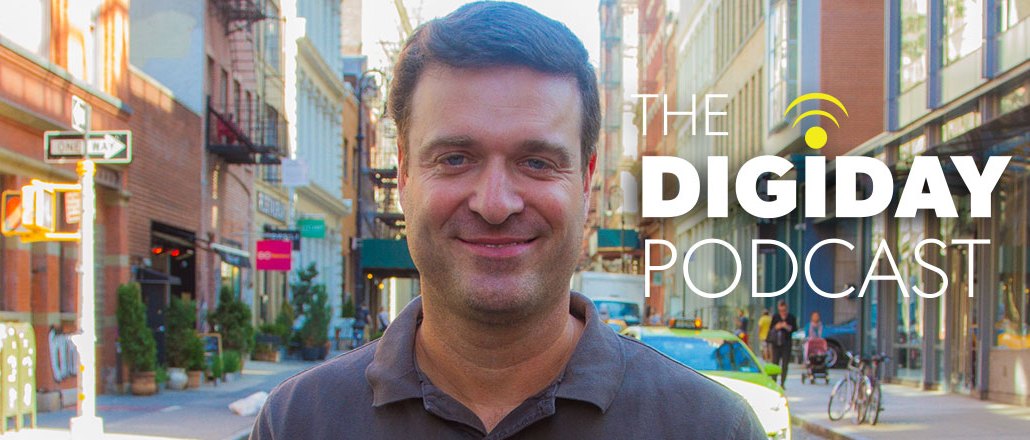Save 50% on a 3-month Digiday+ membership. Ends Dec 5.
Huge CEO Aaron Shapiro on how to become a big agency without sucking

Subscribe: iTunes | Stitcher | RSS
A decade ago, Huge was a bootstrapped startup agency in a 200-square foot room in Brooklyn with about 10 employees. Now, it’s 1,400 people with offices around the globe growing 30 percent a year.
Aaron Shapiro, Huge’s CEO who joined the company in its early days, said on this week’s Digiday Podcast that each year brings both growth and a new set of challenges. Early on, startups are about keeping the lights on. While now, it’s more about how to grow without losing what made the agency successful to begin with.
“Our business is about great work at scale,” he said. “How do we continue doing great work, realizing if we continue to do that, we’re going to grow. It’s inevitable in the future that Huge will be twice the size. The question I have for my management team is not how do we become twice the size; it’s how do we make sure when we’re twice the size Huge’s work is better than it is today.”
Huge wasn’t able to make its own products
With marketers turning to procurement departments to jam down agency costs, many agencies looked to the nirvana of creating their own products where they’d be free from the fee-for-services trap. Huge was one of them with its Huge Labs initiative. It didn’t work, however. The reason, Shapiro said, is simple: The capital requirements for a product business model are a bad fit with a services business.
“Building products and doing work for our clients is in complete and utter conflict,” Shapiro said. “The business models are very different. Consulting services are variable costs. We sell the hours we pay in salaries. Products are a fixed-costs business. You build the software and then you sell it on an ongoing basis. Because of that conflict it’s very hard to normalize them together.”
Ad position: web_incontent_pos1
Clients asked for websites but wanted something else
From the early days, digital agencies like Huge, Razorfish, R/GA and others often built websites for clients. But that was a bit of a misnomer, Shapiro said, since what they were really asking for was a way to navigate the changes the Internet was causing to their businesses and the competitive landscape.
“While our services are much broader, I don’t think the core of what we do has really changed, which is fundamentally every client, whether they realize it or not, is going through a massive shift in the next 10 years and really struggles with relevance in the modern economy,” Shapiro said. “The difference is 15 years ago it was hypothetical, and today it’s brutally obvious.”
Marketers biggest challenge is internal
There was a time when many companies were in denial or ignorant of the big changes going on with technology. Now, with Uber upending the taxi system, Airbnb threatening hotels and Blockbuster in bankruptcy, there’s little doubt that transformation is an imperative. But the problem now is with internal structures, Shapiro said.
“Most companies were built in an analog world and were not set up to think about their marketing and broader business model in the modern economy,” he said. “We’re at a stage now where clients don’t have to be educated about this. The challenge is their business models and their internal expertise don’t align with the reality of what has to happen for them to change.”
Digital agencies want to be just agencies
Digital agencies got their starts in building websites, but they now want to do it all, including TV work. The idea, according to Shapiro, is digital agencies are best positioned to stitch together all the marketing a client needs across tech, marketing and advertising.
Ad position: web_incontent_pos2
“Clients increasingly want to hire one agency to get their marketing work done,” Shapiro said. “The benefit is there’s a holistic, user-centric approach to marketing that spans all of these different touchpoints. It’s anchored in digital but expands everywhere.”
More in Marketing

Ulta, Best Buy and Adidas dominate AI holiday shopping mentions
The brands that are seeing the biggest boost from this shift in consumer behavior are some of the biggest retailers.

U.K. retailer Boots leads brand efforts to invest in ad creative’s data layer
For media dollars to make an impact, brands need ad creative that actually hits. More CMOs are investing in pre- and post-flight measurement.

‘AI is permeating everything we do’: How Guitar Center developed 2 AI tools this year
This summer, the company launched a chatbot called Rig Advisor to help customers find the right instruments and products.
Ad position: web_bfu